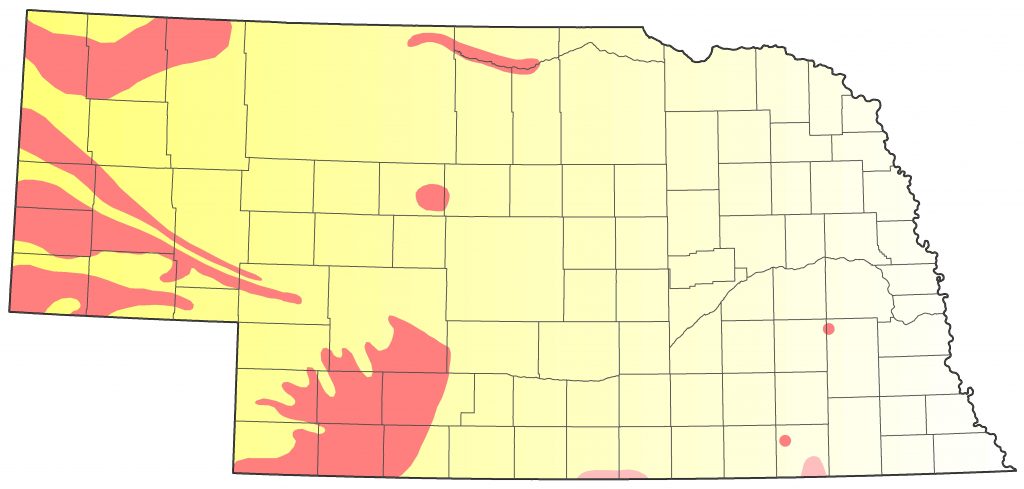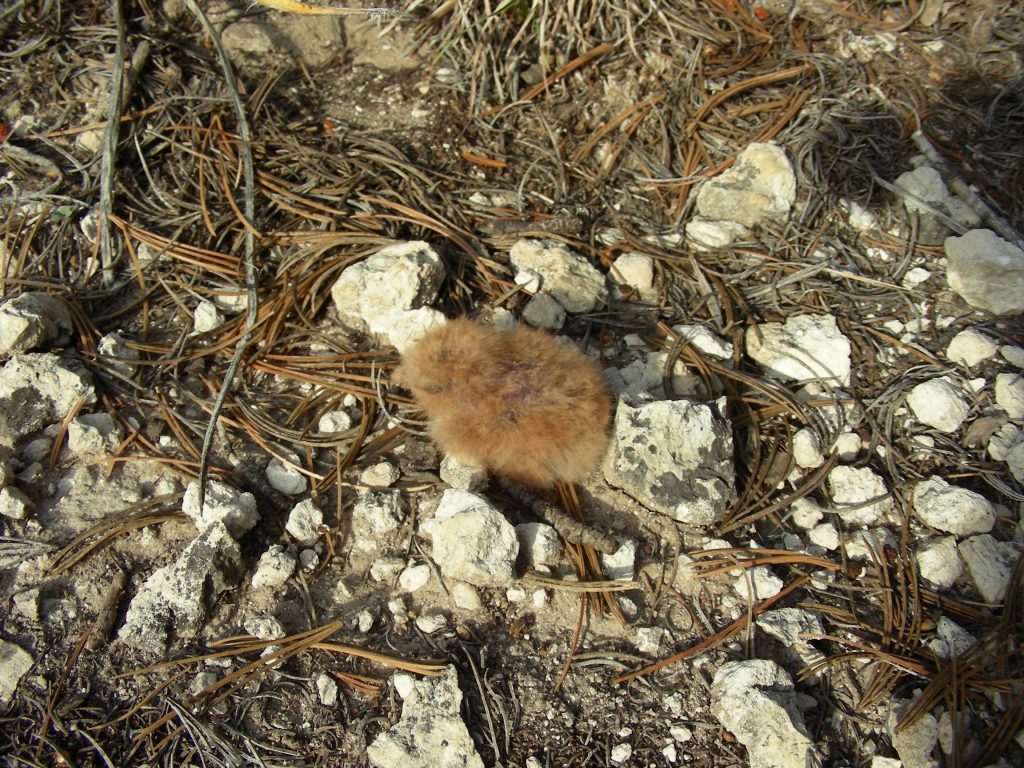Phalaenoptilus nuttallii nuttallii
Status: Common regular spring and fall migrant west and west central, uncommon east central, rare casual east. Common regular breeder west, uncommon central, rare casual east. Documentation: Specimen: UNSM ZM6247, 24 May 1900 Monroe Canyon, Sioux Co.
Documentation: Specimen: UNSM ZM6247, 24 May 1900 Monroe Canyon, Sioux Co.
Taxonomy: Of the six subspecies recognized (AviList 2025), only one occurs as far north as Nebraska east of the Rocky Mountains, nuttallii of southwest Canada, west and west-central USA and northern Mexico.
Nebraska birds are nuttallii.
Spring: Apr 26, 26, 28 <<<>>> summer
Arrival is in early May, although there are earlier dates of one photographed at Imperial, Chase Co 7 Apr 2020, two recorded in Dundy Co 8 Apr 2017, 12 Apr 2011 Lincoln Co, 12 Apr (year not given) in the Keith Co area (Brown and Brown 2001), 15 Apr 2023 Moran Canyon, Lincoln Co, 18 Apr Keith Co (Johnsgard 1990), and 23 Apr 2024 (3) Wildcat Hills, Scotts Bluff Co.
The presence of this species in the western Loup drainage in summer, especially Thomas Co, suggests migrants should occur virtually throughout the west and central, although reports are few for this nocturnal species.
The only records from the east are two specimens, HMM 26993 collected at Bladen, Webster Co 26 Apr 1951 and a male collected 2 May 1901 at Kearney, Buffalo Co (Swenk, Notes Before 1925), one flushed and well-described during planting in Dodge Co 7 May 2021 (Don Paseka, personal communication), singles calling 7 and 8 May 2012 at Rock Glen WMA, Jefferson Co, one calling at Spring Creek Prairie, Lancaster Co, 21 May 2007, and singles at Bohemia Prairie WMA, Knox Co 25 May 1986 and 31 May 1988.
- High counts: 11 on Wright’s Gap Road, Banner Co 21 May 2021, 10 on Wright’s Gap Road, Scotts Bluff Co 22 May 2020, 6 at Ash Hollow SHP, Garden Co 17 May 1995, 6 on Old Stage Road, Scotts Bluff Co 20 May 2023, 6 at Exit 1 on I-80, Kimball Co 28 May 2024, and 6 at Gilbert-Baker WMA, Sioux Co 30 May 2024.
Summer: Nebraska is at the eastern edge of the species’ breeding range, where it occupies areas of pines or brushy woodlands associated with rocky terrain. Such habitat occurs primarily in the northern Panhandle (Rosche 1982), but extends eastward along the Niobrara River Valley (Brogie and Mossman 1983; Mossman and Brogie 1983), the North Platte River Valley (Johnsgard 1990; Rosche 1994), and occurs in the Loess Canyons of Lincoln Co (Thomas J. Walker, pers. comm.), and, in the southwest, scarps above Frenchman Creek in Chase, Hayes, and Hitchcock Cos. Fire may preclude poorwills from using ponderosa pine habitat; none have been present through Jun 2016 after an extensive 2012 fire in the Niobrara Valley Preserve (Clem Klaphake, personal communication).
Various authors (Johnsgard 1980, Haecker et al 1945) have indicated that breeding may occur further to the east than outlined above. There are several summer reports for Knox and Holt Cos, suggesting that breeding may occur throughout the Niobrara River Valley; a few were found May 2008 in Gregory Co, South Dakota, north of Atkinson, Holt Co, Nebraska, in “rugged Missouri River bluffs on the west side of Lake Francis Case; this habitat is “open prairie with scattered thickets and cedars, and represents a habitat type that may be found in Knox and Boyd Cos along the Missouri or Niobrara Rivers” (William F. Huser, personal communication). Singles were in Brown and Keya Paha Cos 19 Jun 2012, up to three were heard at Bohemia Prairie WMA, Knox Co 7-9 Jul 2008, five were near Lynch, Boyd Co 2 Jul 2015, and one was calling in Knox Co 13 Jul 2025.
Common Poorwill occupies similar mixed grassland-coniferous habitat which has been created at NNF Bessey, Thomas Co (Bray 1994; Smith 1957; Ford 1959). Bray (1994) considered it a “common summer resident and nester” there, although it was not reported there until 1956. A female in breeding condition was collected there 8 Jul 1957 (Ford 1959). Twelve were counted there 28 Aug 1999.
There was only a single Lincoln Co summer report, 6 Jun 1954, until Thomas J. Walker began systematic nocturnal surveys of the Loess Canyons in southeast Lincoln Co. Following discovery of a road-killed bird 22 Jun 2004, Walker has found birds in summer of each year since, including “dozens” on the dirt canyon roads there 16 Jun 2007. Eleven stops on a BBS route there 2.30-5.30 am 28 Jun 2010 yielded a count of 11 birds.
The distribution map for Kansas (Thompson et al 2011; Busby and Zimmerman 2001) suggests that at least occasional nesting may occur in Nebraska south of the Platte River, especially in rocky areas in native grasslands, such as areas south of the Republican River in Webster and Franklin Cos, Sandstone Prairies of southern Jefferson Co, and east perhaps to Gage Co. Thompson et al (2011) suggested this species may be more common in the Flint Hills of eastern Kansas than in western Kansas. Immediately north of the Flint Hills in Nebraska there are in fact two nesting records. A successful nest was observed in Lancaster Co mid-May 1976 (Cortelyou 1977), and another, with eggs, was found and observed 27 May-4 Jun 1963 near Powell, Jefferson Co (Hoge 1964). At least one calling bird was at Twin Oaks WMA, Johnson Co 5-7 Jun 1982 (Cortelyou 1982), and at Rock Glen WMA, southeast Jefferson Co, 1-3 birds were found 7-24 May 2012. Two were heard near Franklin, Franklin Co 2 Jun 2021 and one was recorded near Red Cloud, Webster Co 3 Jun 2021.
- Breeding Phenology:
Eggs: 15 May- 14 Aug (Mollhoff 2022)
Nestlings: 15 May- 14 Aug (Mollhoff 2022)
A nest with two eggs in Dawes Co as late as 13 Aug was thought to be a second nesting (Mollhoff 2001).
- High counts: 13 at Gilbert-Baker WMA, Sioux Co 9 Jun 2023, 12 in Sowbelly Canyon 13 Jun 1998, 12 at Red Willow Reservoir, Frontier Co 6 Jun 2006, 6 at Gilbert-Baker WMA, Sioux Co 4 Jun 2020, and 5-7 at Chadron SP, Dawes Co 3 Jun 2005.

Fall: summer <<<>>> Oct 7, 7, 9
Departure is difficult to determine as these birds usually stop calling in Jul. While most probably leave in Sep, there are later records, mainly road-killed specimens and banded birds in early Oct, and it has been found in the Keith Co area through mid-Oct (Brown and Brown 2001).
Late dates above include a specimen captured alive near Valparaiso, Lancaster Co, banded, photographed, and released in Lincoln 7 Oct 1974 (Cortelyou 1977).
Later dates are of one south of Gering, Scotts Bluff Co 11 Oct 1999, one reported from Crescent Lake NWR, Garden Co 20 Oct 1996, one studied closely in snow near Stromsburg, Polk Co 23 Oct 2009 (Brogie 2009), and another extremely late record of a road-killed specimen in Lancaster Co 1 Nov 1970 that had been dead several days and is now UNSM ZM12946 (Cink and Fiala 1971).
Easterly (and late- see above) dates were 20 Sep 1930, found dead in Adams Co (Jorgensen 2012), 7 Oct 1974 Lancaster Co (specimen discussed above), one in snow in Polk Co 23 Oct 2009, and one road-killed in Lancaster Co 1 Nov 1970.
- High counts: 10 along Old Stage Road, Scotts Bluff Co 25 Aug 2020, 7 there 4 Aug 2023, and 6 there 15 Jul 2013.
Abbreviations
BBS: Breeding Bird Survey
HMM: Hastings Municipal Museum
NNF: Nebraska National Forest
NWR: National Wildlife Refuge
SHP: State Historical Park
SP: State Park
UNSM: University of Nebraska State Museum
WMA: Wildlife Management Area (State)
Acknowledgement
Photograph (top) of a Common Poorwill on a nest in West Ash Canyon, Dawes County 14 Aug 1999 by Wayne Mollhoff.
Literature Cited
AviList Core Team, 2025. AviList: The Global Avian Checklist, v2025. https://doi.org/10.2173/avilist.v2025.
Bray, T.E. 1994. Habitat utilization by birds in a man-made forest in the Nebraska Sandhills. Master’s thesis, University of Nebraska-Omaha, Omaha, Nebraska, USA.
Brogie, M.A. 2009. 2009 (21st) Report of the NOU Records Committee. NBR 77: 160-168.
Brogie, M.A., and M.J. Mossman. 1983. Spring and summer birds of the Niobrara Valley Preserve, Nebraska: An annotated checklist. NBR 51: 44-51.
Brown, C.R., and M.B. Brown. 2001. Birds of the Cedar Point Biological Station. Occasional Papers of the Cedar Point Biological Station, No. 1.
Busby, W.H., and J.L. Zimmerman. 2001. Kansas Breeding Bird Atlas. University Press of Kansas, Lawrence, Kansas, USA.
Cink, C.L., and K.L. Fiala. 1971. First specimen of Poor-Will from Lancaster County; A summary of Poor-Will migration. NBR 39: 70-71.
Cortelyou, R.G. 1977. Poor-wills in Lancaster and Saunders Counties. NBR 45: 42-44.
Ford, N.L. 1959. Notes on summer birds of western Nebraska. NBR 27: 6-12.
Haecker, F.W., R.A. Moser, and J.B. Swenk. 1945. Checklist of the birds of Nebraska. NBR 13: 1-40.
Hoge, G.L. 1964. Poorwills near Powell. NBR 32: 14.
Johnsgard, P. A. 1980. A preliminary list of the birds of Nebraska and adjacent Great Plains states. Published by the author, University of Nebraska, Lincoln, USA.
Johnsgard, P.A. 1990. Additional observations of the birds of the Lake McConaughy region. NBR 58: 52-54.
Jorgensen, J.G. 2012. Birds of the Rainwater Basin, Nebraska. Nebraska Game and Parks Commission, Lincoln, Nebraska, USA.
Mollhoff, W.J. 2022. Nest records of Nebraska birds. Nebraska Ornithologists’ Union Occasional Paper Number 9.
Mossman, M.J., and M.A. Brogie. 1983. Breeding status of selected bird species on the Niobrara Valley Preserve, Nebraska. NBR 51: 52-62.
Rosche, R.C. 1982. Birds of northwestern Nebraska and southwestern South Dakota, an annotated checklist. Cottonwood Press, Crawford, Nebraska, USA.
Rosche, R.C. 1994. Birds of the Lake McConaughy area and the North Platte River valley, Nebraska. Published by the author, Chadron, Nebraska, USA.
Smith, C.E. 1957. Thomas County. NBR 25: 27.
Swenk, M.H. Notes before 1925. Bird notes from A.M. Brooking of Hastings, C.A. Black of Kearney, and B.J. Olson of Kearney, based chiefly on their collections, up to January 1, 1925. Typed manuscript in the Nebraska Ornithologists’ Union Archives, University of Nebraska State Museum, Lincoln, Nebraska, USA.
Thompson, M.C., C.A. Ely, B. Gress, C. Otte, S.T. Patti, D. Seibel, and E.A. Young. 2011. Birds of Kansas. University Press of Kansas, Lawrence, Kansas, USA.
Recommended Citation
Silcock, W.R., and J.G. Jorgensen. 2025. Common Poorwill (Phalaenoptilus nuttallii). In Birds of Nebraska — Online. www.BirdsofNebraska.org
Birds of Nebraska – Online
Updated 20 Jul 2025
